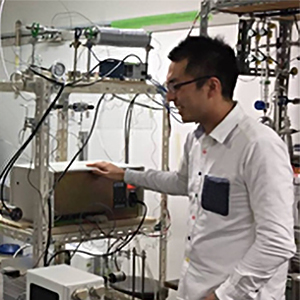Press release with author’s message
— From ArCS II News Letter No.2 —
ArCS II News Letter No.2 introduced press releases issued in 2021 spring with authors’ messages telling their thoughts, future prospect, and backstories of their research projects. The topics include marine biodiversity, the impact of COVID-19 on global warming, atmospheric aerosol dynamics, and relationships between heatwaves and wildfires.
*Affiliations are at the time of the newsletter publication.
Safe havens of marine biodiversity in the Bering Sea shelf

Irene D. Alabia
(Arctic Research Center, Hokkaido University)
Marine biodiversity provides valuable ecosystem services. Understanding the patterns and factors structuring biodiversity is crucial for conservation and management. Recent climate change has caused significant biodiversity impacts, and effective means of mitigating its rapid loss are constantly being sought. We explored a conservation approach that identifies refugia, which are regions relatively buffered from impacts of ongoing climate change.
These provide favorable habitats for species when the surrounding environment becomes harsh, allowing their survival under climate change. Our work underpins their importance in biologically sustaining climatically-exposed ecosystems in the Bering Sea.
| Title | Marine biodiversity refugia in a climate-sensitive subarctic shelf |
| Journal | Global Change Biology |
| Published | April 25, 2021 |
| Authors | Irene D. Alabia, Jorge Garcia Molinos, Takafumi Hirata, Franz J. Mueter, Toru Hirawake, ,Sei-Ichi Saitoh |
| DOI | https://doi.org/10.1111/gcb.15632 |
See Press Release
How did COVID-19 lockdowns affect the climate?

Naga Oshima
(Meteorological Research Institute, Japan Meteorological Agency)
Emissions of anthropogenic substances decreased globally due to lockdowns and other measures taken worldwide in the wake of the new
coronavirus disease (COVID-19) pandemic. However, we found that there were no detectable changes in the ground-level temperature or precipitation. It is also meaningful that researchers across the world cooperated swiftly at a time of emergency, launched a multi–Earth system model intercomparison project through an international study team, and were able to come up with highly reliable estimates in several months (such a project usually takes several years). I think it important to continue research taking advantage of such an international framework in the future
as well.
| Title | The Climate Response to Emissions Reductions Due to COVID-19: Initial Results From CovidMIP |
| Journal | Geophysical Research Letters |
| Published | April 29, 2021 |
| Authors | Chris D. Jones, Jonathan E. Hickman, Steven T. Rumbold, Jeremy Walton, Robin D. Lamboll, Ragnhild B. Skeie, Stephanie Fiedler, Piers M. Forster, Joeri Rogelj, Manabu Abe, Michael Botzet, Katherine Calvin, Christophe Cassou, Jason N.S. Cole, Paolo Davini, Makoto Deushi, Martin Dix, John C. Fyfe, Nathan P. Gillett, Tatiana Ilyina, Michio Kawamiya, Maxwell Kelley, Slava Kharin, Tsuyoshi Koshiro, Hongmei Li, Chloe Mackallah, Wolfgang A. Müller, Pierre Nabat, Twan van Noije, Paul Nolan, Rumi Ohgaito, Dirk Olivié, Naga Oshima, Jose Parodi, Thomas J. Reerink, Lili Ren, Anastasia Romanou, Roland Séférian, Yongming Tang, Claudia Timmreck, Jerry Tjiputra, Etienne Tourigny, Kostas Tsigaridis, Hailong Wang, Mingxuan Wu, Klaus Wyser, Shuting Yang,Yang Yang,Tilo Ziehn |
| DOI | https://doi.org/10.1029/2020GL091883 |
See Press Release
Ice core data show why, despite lower sulfur emissions, air pollution is dropping more slowly

Shohei Hattori
(School of Materials and Chemical Technology, Tokyo Institute of Technology)
After SO2 emission control in the 1970-80s, relatively lower atmospheric acidity promotes the efficiency of the sulfate production in the atmosphere, which weakens the response of the sulfate level to SO2 reduction. Our unique isotopic techniques applied for Greenland’s SE-Dome records identify the key process of the weakened response of sulfate to SO2 emissions reduction. In future research, we need to understand this multiphase chemistry in the atmosphere to design an efficient strategy to manage air pollution and accurately predict future air pollution and climate change impacts. I am glad to publish this result based on international research collaboration, although it took almost two years after the first draft.
| Title | Isotopic evidence for acidity-driven enhancement of sulfate formation after SO2 emission control |
| Journal | Science Advances |
| Published | May 5, 2021 |
| Authors | Shohei Hattori, Yoshinori Iizuka, Becky Alexander, Sakiko Ishino, Koji Fujita, Shuting Zhai, Tomás Sherwen, Naga Oshima, Ryu Uemura, Akinori Yamada, Nozomi Suzuki, Sumito Matoba, Asuka Tsuruta, Joel Savarino, Naohiro Yoshida |
| DOI | https://doi.org/10.1126/sciadv.abd4610 |
See Press Release
Newly identified atmospheric circulation pattern enhances heatwaves and wildfires around the Arctic

Teppei J. Yasunari
(Arctic Research Center, Hokkaido University)
In recent years, summer heatwaves and wildfires in the northern hemisphere have become frequent topics of conversation. The simultaneous occurrence of summertime heatwaves and wildfires is a concern for human health regarding temperature and air pollution. Some coincidences could result in the discovery and the paper publication of the climatic (atmospheric circulation) pattern. The discovery of this climatic pattern and its characteristics in recent years was made possible by a couple of coincidences, starting with a chatty discussion among researchers in our team at an international conference and ending with the results of analyses by individual researchers. I fully felt the wonderfulness of conference chatting and collaborative research at this time. In the future, it will be essential to elucidate the mechanism of this climate pattern and the changes associated with global warming to predict the simultaneous occurrence of heatwaves and wildfires.
| Title | Relationship between circum-Arctic atmospheric wave patterns and large-scale wildfires in boreal summer |
| Journal | Environmental Research Letters |
| Published | May 17, 2021 |
| Authors | Teppei J Yasunari, Hisashi Nakamura, Kyu-Myong Kim, Nakbin Choi, Myong-In Lee, Yoshihiro Tachibana, Arlindo M da Silva |
| DOI | https://doi.org/10.1088/1748-9326/abf7ef |
See Press Release
